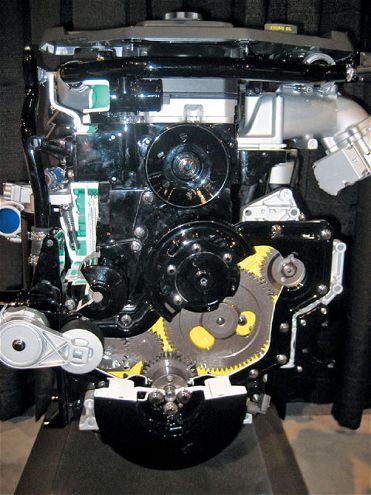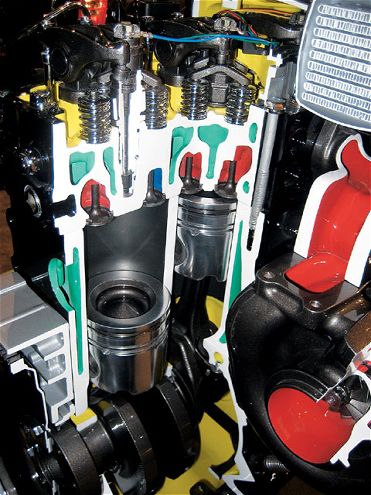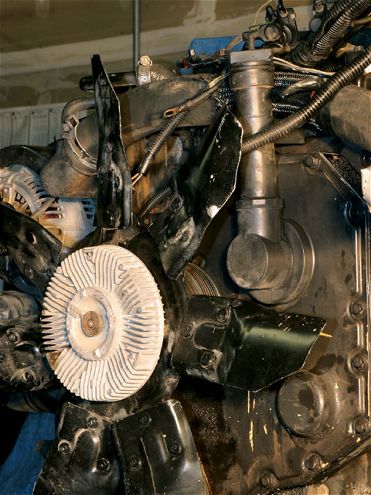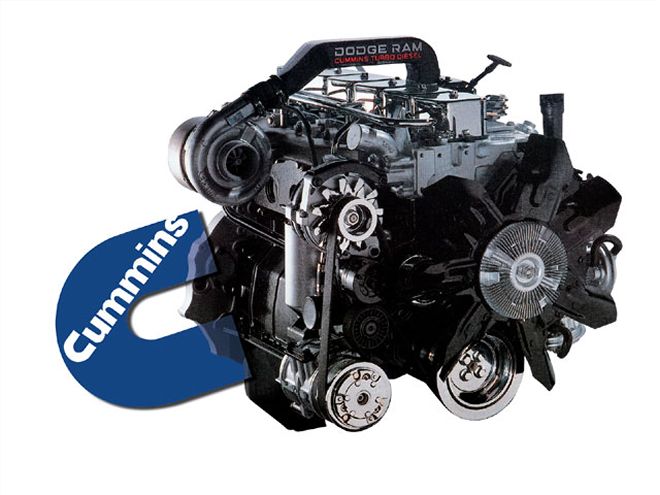
| dodge Ram 6bt5point9 Cummins Engine engine 1
To those who are new to the diesel game, the Cummins B-series engine is thought of as an inline-six-cylinder engine that's used in Dodge trucks. In reality, the B-series product line consists of three-, four-, and six-cylinder, high-swirl, direct-injection engines with a displacement of 0.98L per cylinder and a bore of 4.02 inches and a stroke of 4.72 inches. The entire B-series family was designed to withstand high levels of turbocharging with conservative component loading.
6 = six-cylinder B = B-series T = turbocharged 5.9 = 5.9L
A Successful DesignWhen the B-series project was initiated by Cummins in September 1978, a special team was formed to focus resources, and the effort eventually grew to 214 people. The original B-series engines were manufactured at a joint-venture plant in Rocky Mount, North Carolina, that was owned by the Cummins Engine Co. and the J.I. Case Co.
The seven most important design objectives for the B-series engine were durability, reliability, emissions, performance, application adaptability, cost, and serviceability. In July 1983, production was started on the four-cylinder version for industrial applications. That was the first of new product introductions planned for the following three years. The engines were engineered to cover a broad power range in turbocharged and normally aspirated form. The original B-series engine enjoyed mechanical fuel distribution with 17mm closed-nozzle injectors.
Dodge And CumminsIn the early '80s, Chrysler was searching for a diesel powertrain to use in it's 3/4- and 1-ton trucks. By the end of 1983, industry sales of the larger pickup trucks were showing 22 to 25 percent diesel penetration, as established from market data representing Ford and General Motors products, respectively. Performance, durability, and fuel economy were the driving forces behind the diesel's acceptance.
The Cummins 6BT5.9 engine clearly possessed the necessary qualities to satisfy Dodge's market requirements. The modern design also had the compact size and weight that would be required for use in the '89-'93 line of Dodge trucks. In addition, Cummins' strong reputation among diesel truck owners and operators and its predominant presence in the Class 8 truck market was viewed as a strong advantage by Chrysler. In November 1984, Chrysler completed a nonfunctional hardware mockup of the proposed engine installation. A running concept vehicle was completed by Cummins in February 1985, and it confirmed the viability of the engine and vehicle combination.
The BlockThe cast-iron engine block used a linerless design that had several important engineering functions. The block held an integrally cast oil cooler cavity, water pump volute, oil pump cavity, and the camshaft didn't require press-in bearings.
Cylinder HeadThe cast-iron cylinder head used a two-valve design with the intake and exhaust ports entering from opposite sides (crossflow). Helical intake ports were used to achieve the high-swirl requirements, and the intake manifold was cast integrally with the head. This reduced cost and provided a smooth transition at the critical entrance to the intake ports. Exhaust ports were exposed to as little water jacket area as possible to increase the available energy to the turbocharger and minimize heat rejection into the cooling system.
The cast-iron cylinder head featured induction-hardened valve seats (Rockwell C-50) to avoid the need for pressed-in seats without compromising mechanical durability. This also provided a cost reduction over traditional inserts. The valveguides were also machined in the parent material of the cylinder head. Six bolts per cylinder were used to attach the head to the block, two of which were shared by adjacent cylinders. One bolt per cylinder also served to clamp the rocker-lever assembly to the cylinder head.
ValvesExhaust and intake valve rocker arms were made of ductile iron, classified as SAE D5506, and operated without bushings on a simple shaft that was pressed into a unique powdered-metal support. This support provided the oil-feed passages, attachment holes, location dowel, and a square protrusion that located the rocker cover without the need for additional machining.
CamshaftMushroom-type, chilled iron tappets operated the valves from the camshaft motion through pushrod tubes (the camshaft was also chilled iron). Die-cast aluminum rocker covers were chosen for cost and structural reasons. This required extensive analysis of the cover to ensure even load distribution to the gasket surface.
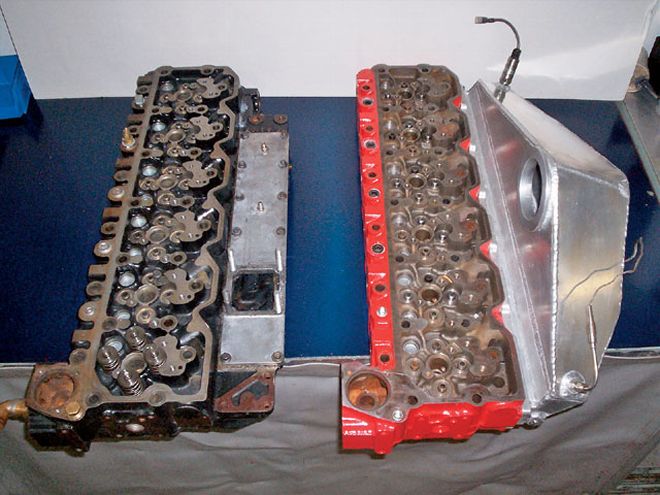
| Stock 24-valve head(left)ANDRace-ported, 24-valve head with custom intake manifold(right)
Accessory DriveThe gear train was composed of six austempered, ductile iron helical gears. The only idler in the systems was a lightly loaded oil-pump idler gear. In addition to driving the oil pump through the idler, the crank gear drove the camshaft gear, which in turn drove the fuel-pump gear and accessory drive system. The accessory drive arrangement was used for a variety of applications such as power-steering pumps, air compressors, and up to a 50hp hydraulic pump.
A permanent-mold aluminum gear housing was used to locate and support the fuel pump and accessory drives, in addition to providing the back side of the enclosure for the gear train. A stamped steel cover carried the front crank seal and completed the enclosure for the gear train. Stamped steel was chosen for both cost and noise attenuation reasons.
Another important stamped steel part was the tappet cover. It not only served to seal the tappet opening in the block, but it also provided a crankcase breather, which allowed operation at 45 degrees angularity in all four directions.
The fan, water pump, and alternator were driven by a serpentine, eight-groove, poly-vee belt system. Several fan center combinations were made possible by keeping the fan drive separate from the water-pump drive. The drive was kept taut by a common automatic belt tensioner, which allowed it to last the life of the engine without adjustment. The fan and crank pulleys were manufactured with a stamping and spinning process. Neither pulley required any machining after being formed.
Oiling SystemThe oiling system on the three- and four-cylinder engines used an identical pump and had a capacity of 15 gallons per minute at 3,600 pump rpm. The six-cylinder pump had longer gears and was rated at 20 gallons per minute at 3,600 pump rpm.
CrankshaftThe crankshaft was forged steel and enjoyed induction-hardened fillets and journals with a front power takeoff capability. The main bearing journal was sized to keep the fillet stress below 35,000 psi and maintain oil film thickness of 0.000083 inch. Connecting-rod journal size was determined primarily by the six-cylinder torsional conditions. Its size was chosen to keep torsional amplitudes below 0.3 degree double amplitude and to achieve an oil film thickness of 0.000064 inch. Both bearing parameters were achieved at maximum load, the result being a very conservative piston, connecting rod, and crankshaft combination.
Connecting RodsThe connecting rods were identical for every cylinder and were used throughout the family of engines. A large 1.57-inch keystone small end was designed to reduce bearing loads and eliminate the need for forced lubrication. The large end of the rod was sized for the six-cylinder crank journal requirements that were imposed by torsional considerations. The resulting journal size forced the need for an angle split connecting-rod cap design to allow for the connecting rod's removal through the cylinder bore. The "shark's fin" location for connecting the cap to the rod was chosen to eliminate dowels and reduce cost by using a broached finish on the mating faces.
PistonsAluminum pistons were used throughout the B-series models. The naturally aspirated piston differed from the turbocharged piston in that it didn't require a Ni-resist cast-iron insert or a keystone top ring. Also, its combustion bowl had a different geometry, and the piston in the turbocharged application featured a three-ring design.
Cold-Start DriveabilityChrysler and Cummins engineers were very aware that many potential owners would have no experience with starting a diesel engine in cold weather, so gasoline-like starting characteristics were established for the engineering team to meet. The goal was for the engine to start and run within three seconds at zero degrees F and above with #2 diesel fuel. Also, the engine would need to start and run within six seconds at -10 degrees with #1 diesel fuel.
To meet those requirements, a single 1,025-cold-cranking-amp battery was factory fitted along with a 4hp gear-reduction starter and synthetic 5W-30 engine oil. The synthetic lubricant provided an increase in the average cranking speed of 15-20 rpm and a decrease of 100 amps from the battery over 10W-30 mineral oil at -10 degrees.
No Glow PlugsThe original cold-starting system was targeted to use an ether-injection design and glow plugs. During testing, it was recognized that these didn't provide consistent or acceptable starting and contributed to objectionable white exhaust smoke during warm-up.
The search for an alternative aid centered on the concept of heating the intake air to improve starting performance. Several devices were considered, but an electric grid-type heater appeared to be the most logical solution. This component is not to be confused with the glow plugs that heat the combustion chamber, but rather, this unit heats the incoming air. During engine tests, the air heater provided quicker starts over the other systems. Engines equipped with the heater would run smoother after start and weren't as prone to stalling when compared with engines that had ether and glow plugs. The heater system also had a post-start mode to reduce white smoke generated by unburned fuel in the exhaust. To minimize the load on the electrical system, it was proposed that a microprocessor be used to control heater cycles. The result was air-heater operation beginning at intake air temperatures below 60 degrees. The maximum amount of preheat was 20 seconds at temperatures below -15 degrees.
The heater system consisted of the air-heater unit mounted on the intake manifold cover, the microprocessor mounted on the left side of the dashpanel, two relays on the left inner splash shield, and a temperature sensor in the intake manifold.
Engine CoolingEngine cooling was also a concern and proved to be a challenge. The longer overall length of the 6BT5.9 diesel engine when compared with a gasoline V-8 had the most influence on the final system configuration for Dodge.
The Cummins engine cooling requirements for the 6BT5.9 in a Dodge truck were that the system must provide enough heat rejection so the radiator top tank temperature wouldn't exceed 230 degrees at an ambient temperature of 100 degrees during any road load or grade condition. This goal was achieved with a 1.5-inch-thick, high-efficiency, down-flow radiator core with two rows of tubes and 16 fins per inch. It was made of heavy-duty copper and brass. The fan was 20 inches in diameter and had seven blades with a 2.4-inch projected width. The fan was operated by a viscous clutch that was beltdriven at 1.35 times the engine speed. A full box-type plenum fan shroud was the last component.
 | dodge Ram 6bt5point9 Cummins Engine engine 1
To those who are new to the diesel game, the Cummins B-series engine is thought of as an inline-six-cylinder engine that's used in Dodge trucks. In reality, the B-series product line consists of three-, four-, and six-cylinder, high-swirl, direct-injection engines with a displacement of 0.98L per cylinder and a bore of 4.02 inches and a stroke of 4.72 inches. The entire B-series family was designed to withstand high levels of turbocharging with conservative component loading.
6 = six-cylinder
| dodge Ram 6bt5point9 Cummins Engine engine 1
To those who are new to the diesel game, the Cummins B-series engine is thought of as an inline-six-cylinder engine that's used in Dodge trucks. In reality, the B-series product line consists of three-, four-, and six-cylinder, high-swirl, direct-injection engines with a displacement of 0.98L per cylinder and a bore of 4.02 inches and a stroke of 4.72 inches. The entire B-series family was designed to withstand high levels of turbocharging with conservative component loading.
6 = six-cylinder
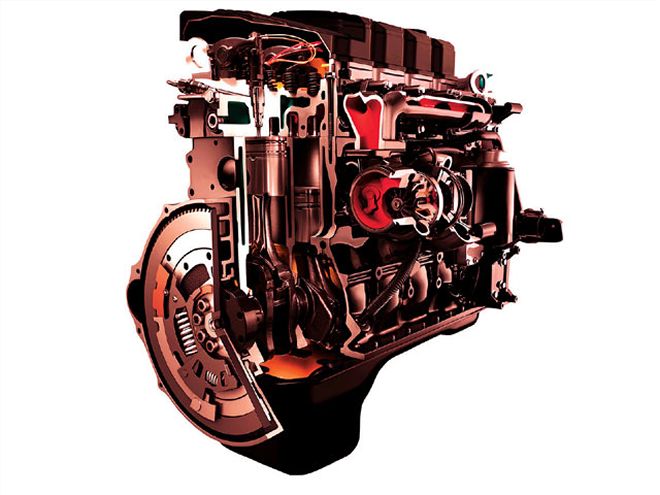
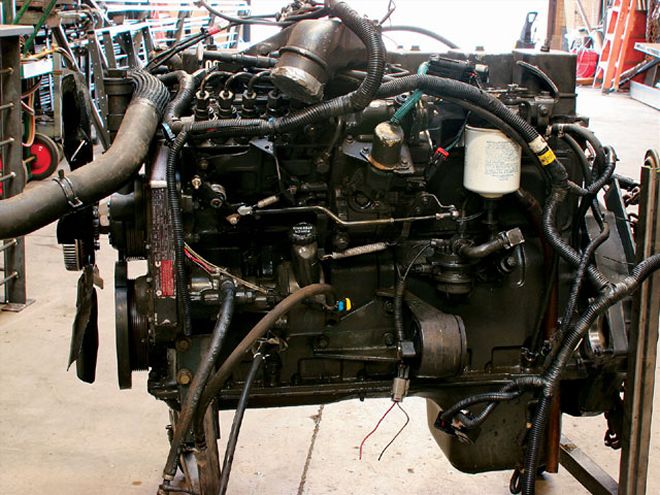
 | Stock 24-valve head(left)ANDRace-ported, 24-valve head with custom intake manifold(right)
Accessory Drive
| Stock 24-valve head(left)ANDRace-ported, 24-valve head with custom intake manifold(right)
Accessory Drive